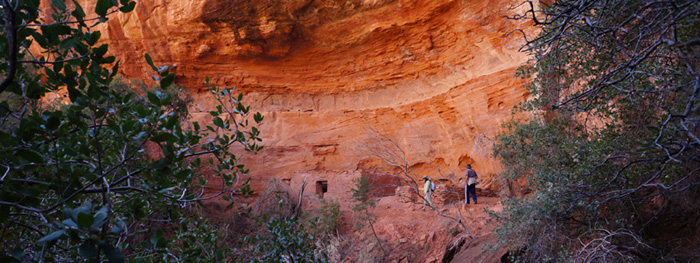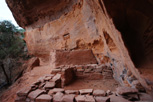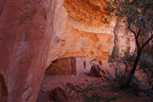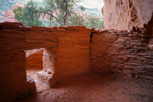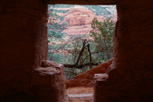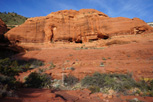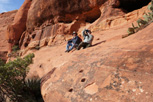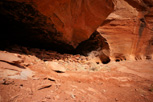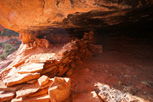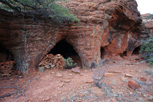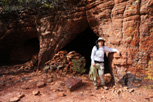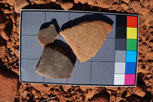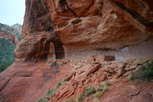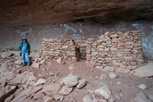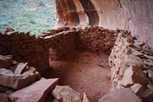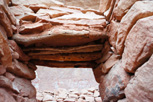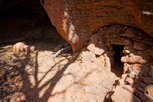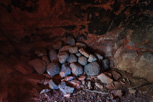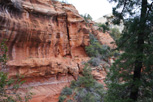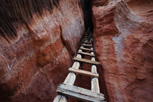Canyon "L" is one of several canyons slicing deep into the Red Rock Secret Mountain Wilderness, west of Sedona. In a series of three expeditions in early 2012, we located and photographed four archeological sites.
The first site is a classic cliff dwelling (see the title photo, and photos 1 through 4). Well protected under an overhang of red rock, it is exceptionally well preserved, with its mud mortar and plaster coating largely intact.
One of the unusual aspects of this ruin is the T-shaped door. This is a hallmark of Anasazi structures found in the Four-Corners region, but is rare among the Sinagua.
Photo 4 shows the view out the front door of the ruin. If you look closely, you will see a row of caves halfway up the cliff on the opposite side of the canyon. This is the location of Site 2, described below.
A side note: Carved into the plaster on the inside of this ruin is the name "J. E. Purtymun," and the dates Dec. 12, 1918, and Jan. 26, 1927 (see photo). The Purtymuns were an historic Oak Creek family, who circa 1896 built a trail that still bears their name from Oak Creek Canyon up to the Mogollon Rim. "J. E." may be Jess Purtymun, a colorful character who once lived in a cave in Oak Creek Canyon, played the accordion, engaged in bootlegging, and who in 1924 built one of the first residences in Oak Creek, which still stands today.
The second set of ruins is located in a series of natural caves halfway up the side of the canyon (photos 5 through 8). The final pitch is steep enough that the inhabitants carved footholds in the rock to ease access (photo 6). Photo 7 shows an outside wall, with white pictographs visible in the background. Photo 8 is a view of the interior of one of the caves, which are surprisingly large. Note the soot covering the ceiling, evidence of ancient cooking fires. At night the caves would have glowed like giant eyeballs, presenting an interesting sight to the residents of Ruin #1.
The third set of ruins is also built into a series of rather odd-looking natural caves (photos 9 through 12). These caves are tall enough to stand up in, and still contain sherds of broken pottery.
The forth ruin is a more conventional cliff dwelling. Although superficially similar to Ruin #1, there are some interesting differences: For one thing, it does not have a T-shaped entrance. For another, this structure includes a back wall, whereas Ruin 1 simply backed up against the face of the cliff. It is possible that this back wall once supported roof timbers, or an entire second story, which would also explain the thickness of the walls.
Not far from Site 2 we found a tiny walled-up cave with an opening about 16 inches wide (photo 17). Much too small to have been used as a habitation, the inside of the cave was crusted with soot and contained an odd pile of rounded stones (photo 18). It's possible that these were manos (pestles), used for grinding corn and nuts. However there was no sign of the metates (mortars) they would have been used with. Another possibility is they may have been cooking stones, which are rocks heated in a fire and then dropped into bowls to boil liquid. If anyone has a different opinion, feel free to share it.
The final mystery is shown in Photos 19 and 20. Located high on a cliff face next to a small ancient ruin is a ladder that disappears up into a dark crevice. The ladder is constructed with nails and so is of (relatively) modern construction, but is so rickety that we dared not climb it. The only safe access would be to rappel down from above. But it was getting late, and we hadn't brought our climbing gear. Whatever secrets are up there will have to wait for another day.
